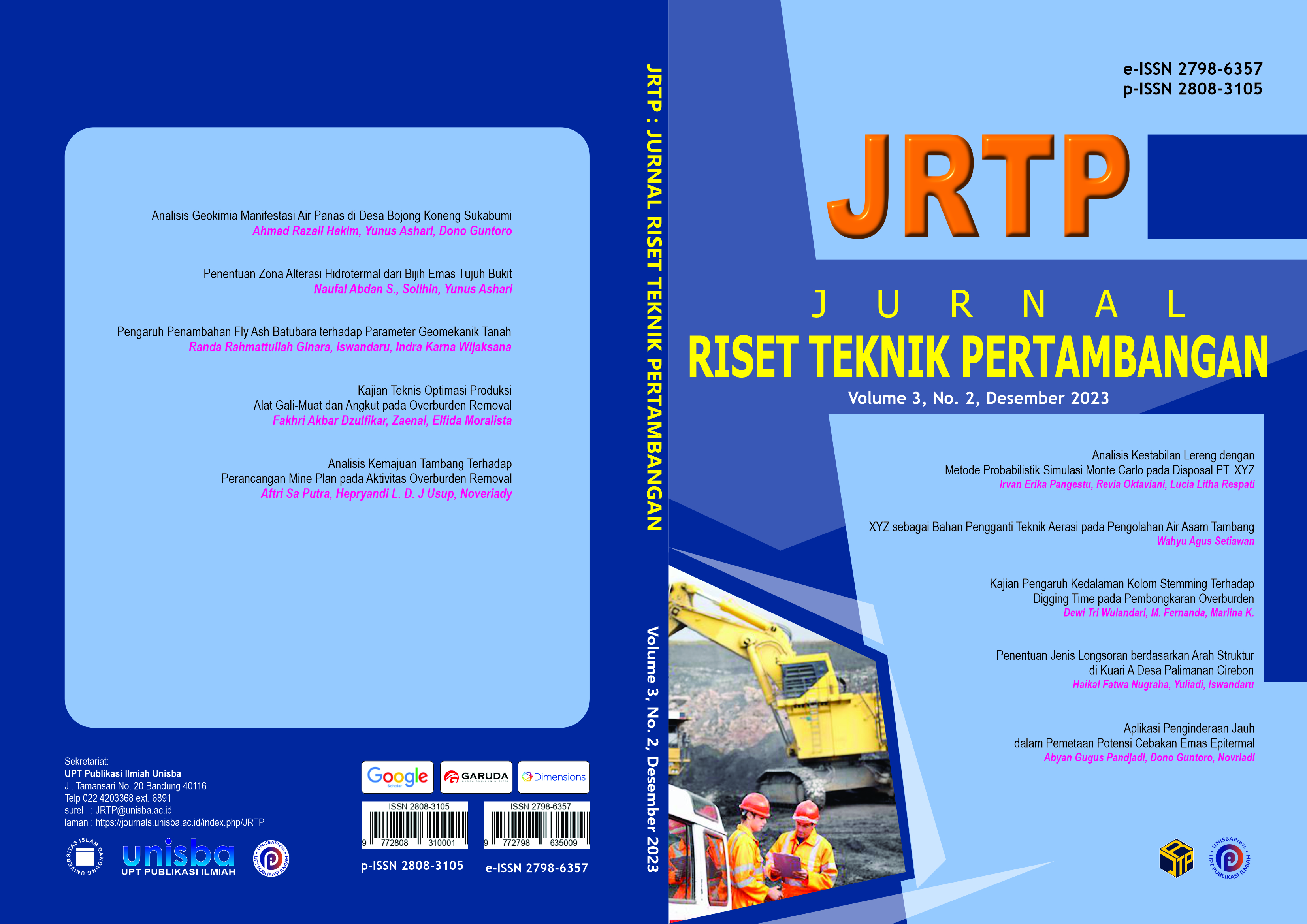Penentuan Zona Alterasi Hidrotermal dari Bijih Emas Tujuh Bukit
DOI:
https://doi.org/10.29313/jrtp.v3i2.2813Keywords:
Mineralisasi, Advanced Argilic, KuarsaAbstract
Abstract. Indonesia, situated along the copper-gold belt, establishes itself as one of the world's largest gold producers, ranking among the top 10. This is attributed to the magmatic belt formed by the convection currents of magma, pushing tectonic plates to create uplift fault zones. These zones serve as pathways for hydrothermal fluids to reach the Earth's surface, forming alteration zones where chemical reactions occur between hydrothermal solutions and surrounding rocks, resulting in mineralization pathways. Tujuh Bukit, one of the largest gold deposits in Indonesia, is formed from porphyry and intermediate to high-sulfide epithermal ore types. This research employs the Corbet and Leach method to determine alteration zones in samples from the Tujuh Bukit area. The study reveals that differences in alteration zones, such as advanced argilic and argilic, impact gold ore formation. The advanced argilic zone exhibits higher temperatures and lower pH compared to the argilic zone. Samples falling within the advanced argilic zone are characterized by the presence of alunite, a product of silicate alteration by sulfuric acid. Quartz content also influences pH and temperature during the alteration process, while one sample falls into the argilic zone. The research involves the collection of secondary and primary data, including geological maps, weather data, X-Ray Diffraction analysis, and Mineralogical Analysis.
Abstrak. Indonesia, sebagai salah satu negara yang terletak pada jalur copper-gold belt, mendudukkan dirinya sebagai salah satu produsen emas terbesar di dunia, masuk dalam 10 besar. Keadaan ini disebabkan oleh jalur magmatis yang terbentuk akibat arus konveksi magma, mendorong lempeng tektonik membentuk zona sesar naik. Zona ini menjadi jalur lemah bagi cairan hidrotermal untuk mencapai permukaan bumi, membentuk zona alterasi tempat terjadinya reaksi kimia antara larutan hidrotermal dan batuan sekitarnya, menghasilkan jalur mineralisasi. Tujuh Bukit, salah satu deposit emas terbesar di Indonesia, terbentuk dari bijih tipe porfiri dan epitermal sulfida menengah hingga tinggi. Penelitian ini menggunakan metode Corbet dan Leach untuk menentukan zona alterasi pada sampel di daerah Tujuh Bukit. Hasil penelitian menunjukkan bahwa perbedaan zona alterasi, seperti advanced argilic dan argilic, mempengaruhi pembentukan bijih emas. Zona advanced argilic memiliki temperatur lebih tinggi dan pH lebih rendah dibandingkan zona argilic. Sampel yang termasuk ke dalam zona advanced argilic ditandai dengan keterdapatan alunit hasil perombakan silikat oleh asam sulfat. Kandungan kuarsa juga berpengaruh terhadap pH dan temperatur selama proses alterasi, sementara satu sampel masuk ke zona argilic. Penelitian ini melibatkan pengumpulan data sekunder dan primer, termasuk peta geologi, data cuaca, analisis X-Ray Diffraction, dan Analisis Mineragrafi.
References
A. Maryono, R. L. Harrison, D. R. Cooke, I. Rompo, and T. G. Hoschke, “Tectonics and Geology of Porphyry Cu-Au Deposits along the Eastern Sunda Magmatic Arc, Indonesia,” Economic Geology, vol. 113, no. 1, pp. 7–38, Jan. 2018, doi: 10.5382/econgeo.2018.4542.
“Mineral commodity summaries 2022,” 2022. doi: 10.3133/mcs2022.
A. Achdan and S. Bachri, “Peta Geologi Lembar Blambangan, Jawa Timur,” Pusat Penelitian dan Pengembangan Geologi. Bandung, 1993.
Sidarto, Suwarti, and Sudana, “Geologi Lembar Banyuwangi, Jawa, Skala 1:100.000,” Pusat Penelitian dan Pengembangan Geologi. Bandung, 1993.
S. F. Simmons, N. C. White, and D. A. John, “Geological Characteristics of Epithermal Precious and Base Metal Deposits,” in One Hundredth Anniversary Volume, Society of Economic Geologists, 2005. doi: 10.5382/AV100.16.
A. W. Rose and D. M. Burt, Hydrothermal alteration, in Geochemistry of Hydrothermal Ore Deposits, 3rd ed. New York: John Wiley & Sons, 1979.
F. Pirajno, Hydrothermal Mineral Deposits. Principles and Fundamental Concept for the Exploration Geologist. New York: Springer-Verlag, 1992.
G. J. Corbett, Epithermal Gold For Explorationists. Australia: AIG Journal Applied Geoscientific Practice and Research, 2002.
Waode Jelita Ma’ruff Bay and Linda Pulungan, “Pemanfaatan Bahan Galian Mineral Kalsit Berdasarkan Karakteristik Sifat Fisik di Cikembar Sukabumi,” Jurnal Riset Teknik Pertambangan, pp. 40–47, Jul. 2022, doi: 10.29313/jrtp.v2i1.994.
D. D. Atmoko, A. D. Titisari, and A. Idrus, “Mineralogi Dan Geokimia Batugamping Merah Ponjong, Gunungkidul, Daerah Istimewa Yogyakarta – Indonesia,” Jurnal RISET Geologi dan Pertambangan, vol. 26, no. 1, p. 55, 2016, doi: 10.14203/risetgeotam2016.v26.269.
Muhammad Aziz Rahmatullah, Sri Widayati, and Solihin, “Pengelolaan Air Asam Tambang Menggunakan Karbon Aktif Fine Coal di Penambangan Batubara,” Jurnal Riset Teknik Pertambangan, pp. 47–54, Jul. 2023, doi: 10.29313/jrtp.v3i1.2126.
Sufriadin, F. Mawardi, and Sri Widodo, “Analisis Pengaruh Ukuran Butir Terhadap Desulfurisasi dan Deashing Batubara Menggunakan Larutan NaOH,” Jurnal Riset Teknik Pertambangan, pp. 15–26, Jul. 2023, doi: 10.29313/jrtp.v3i1.1681.
S. Widodo, Sufriadin, M. Thamrin, Wahyufirmansyah, and N. Jafar, “Mineralogy and quality of Banti Coal, Baraka District, Enrekang Regency, South Sulawesi Province, Indonesia.,” in IOP Conference Series: Earth and Environmental Science, IOP Publishing Ltd, May 2020. doi: 10.1088/1755-1315/473/1/012112.
Menteri ESDM, Pelaksanaan Kaidah Pertambangan Yang Baik Dan Pengawasan Pertambangan Mineral Dan Batubara. Indonesia, 2018.
C. R. Ward, “Analysis origin and significance of mineral matter in coal: An update review,” Int J Coal Geol, vol. 165, pp. 1–27, Aug. 2016.
Ilya Rahma Putri and Dudi Nasrudin Usman, “Analisis Kualitas Batubara Berdasarkan Korelasi Nilai HGI, Moisture Content, dan Volatile Matter,” Jurnal Riset Teknik Pertambangan, pp. 57–64, Jul. 2022, doi: 10.29313/jrtp.v2i1.997.
Vicky Kurnia Nugraha and Noor Fauzi Isniarno, “Analisis Hidrologi untuk Mendukung Rencana Penentuan Temporary Sump pada Tambang Emas,” Jurnal Riset Teknik Pertambangan, pp. 48–56, Jul. 2022, doi: 10.29313/jrtp.v2i1.995.













